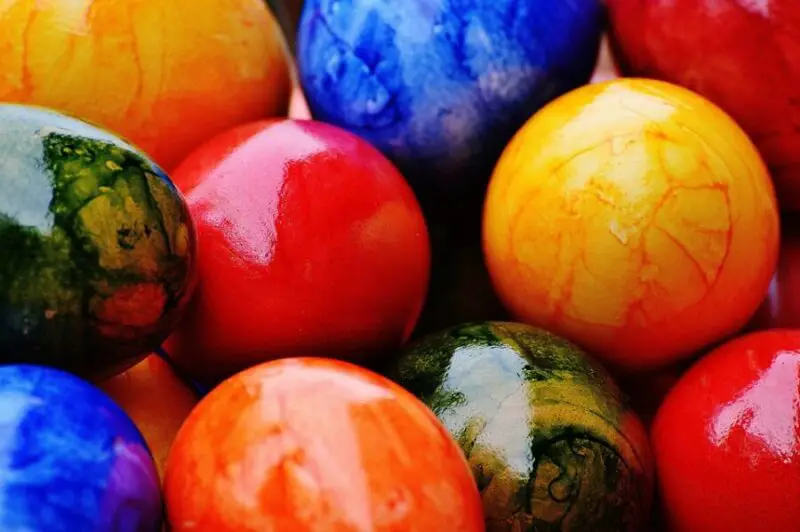Decorating Easter eggs has to be one of the most, if not the most entertaining, parts of Easter. Acrylic paint is often used to decorate eggs because they do a great job, but can you eat acrylic painted easter eggs?
In short, yes, acrylic painted easter eggs can be eaten but not always. There is a longer answer to this question. So, stay tuned with us to find out all the important information that you need to know about eating finished eggs on your Easter holidays.
Table of Contents
Can You Eat Acrylic Painted Easter Eggs?
Before we get into the details, let’s clear the air by saying that acrylic paint is used to paint the shell and not the whites of the egg. With a flat-edge brush and acrylic paint, eggs are commonly decorated. Also, art supplies such as stencils and even cotton swabs are used to make them look more adorable.
such as stencils and even cotton swabs are used to make them look more adorable.

Eggs have to be adequately boiled first; then, they have to be decorated for easy handling. The eggs that have been painted with acrylic paints are completely safe to eat once the shell is peeled off, and as long as you don’t get the paint in your mouth, you’re fine.
However, if you decide to eat easter eggs after picking them up from the hidden egg cups, then please make sure that they are hard boiled eggs. If it is slightly raw and not a hard boiled egg, then there may be risks of getting a foodborne illness.
This is due to bacteria being developed as the decorated Easter eggs usually sit outside for a long time.
We highly recommend cooking the hard boiled eggs using delicious recipes. By boiling it properly, you can be certain that there are no bacteria in your cooked egg. You can then store your dish in the fridge so you can preserve it for a few days.
What Is the Right Dye for Easter Eggs?
For painting the shell of your eggs when decorating, you can essentially use most paints besides any toxic ones. Many of you might want to pick up an old bottle of paint and use it for coloring your eggs, but it’s best to use new ones.
The latter adheres to the eggshell very well, and with the right set of brushes, you can also achieve many unique designs with intricate details. If you have a small child around, be careful and check if they have eaten a bit of the paint since it may be a bit toxic.
We always recommend products such as food safe dyes that are safe for Easter since the decorations you create are very likely to be eaten by some kids. So, when you are buying dyes and paints, ask the store manager if it’s poisonous or not.
Products with too many harsh chemicals should always be avoided because they are hazardous to children.

How to Dye the Inside of the Egg
There are a few ways you can completely dye the egg itself. To begin, let us start with the most standard dying method. In a bowl or a jar, add vinegar and food coloring, 20 drops or more if you want a more intense color. You can also add vegetable oil to the bowl, then dip your hard boiled eggs.
Drop the eggs in the egg dye mixture and leave them overnight inside the fridge. Also, cover the bowl with a plate or close the lid of the jar. Get yourself some tongs so you can toss the eggs around easily, and ensure the eggs are completely submerged, so they dye properly.
Use different colors of dye and vary the dipping time to get unique dyed eggs.
Dry your dyed Easter eggs using a paper towel, and then you can use paint to make them look even cuter. If you dip the eggs in dye, then paint the dyed Easter eggs, you will definitely get a lot of compliments for your decorating skills!
How to Use Shaving Cream to Dye Easter Eggs
If you want to get unique patterned dyed eggs , then the best dying method would be using food coloring and shaving cream. Add a few drops of different food colorings and then create different patterns with a toothpick or a cotton swab.
, then the best dying method would be using food coloring and shaving cream. Add a few drops of different food colorings and then create different patterns with a toothpick or a cotton swab.
Then throw your hard boiled egg in the shaving cream, toss them around, and leave it in there for some time.
After some time has passed, wipe off the shaving cream with a towel, and you should see a beautiful design. As you already know, food coloring is not toxic, and so you can eat dyed easter eggs that have been tossed in the shaving mixture.
This is a very fun way to dye eggs, so you can also do it with kids, especially since the dyed hard boiled eggs are safe to eat. If you get your kids to decorate them, they’ll certainly want to eat dyed easter eggs, so you’ll also be sneaking in some nutrients with this food!
Boil the Eggs Completely through to Prevent Getting ill
We have already said that you should use hard boiled eggs for decorations, but first, you need to understand what that means. After you have boiled the eggs, the white and the yolk of the egg should be pretty firm. Make sure your eggs are at room temperature and leave them in the boiling pot for 15 minutes.
You have to be precise with the timing because if you undercook them, they will be soft and easily develop the bacteria salmonella . On the other hand, if you boil them for a much longer time, the yolk will become a weird greyish green color. Cook them properly, and you can eat dyed eggs as a good protein snack!
. On the other hand, if you boil them for a much longer time, the yolk will become a weird greyish green color. Cook them properly, and you can eat dyed eggs as a good protein snack!
Don’t Leave the Eggs out for Too Long, or They Will Start to Rot
Eggs can start to rot if you leave them out for too long. After all the games are done, you can cook your painted egg to make some dishes, such as an egg roll or cold egg dishes for a snack. If you want to eat eggs later, put them inside an airtight container, and put them in the fridge.
For those of you living in a warmer climate, your painted eggs can be kept outside for about an hour. On the other hand, they can be kept outside for 2 hours without any bacteria developing if the temperature is below 90 Fahrenheit.
The American Egg Board says the hard-boiled eggs can be stored in the refrigerator for up to a week, without the food going off.
says the hard-boiled eggs can be stored in the refrigerator for up to a week, without the food going off.

Final Words
Easter is one of the most exciting holidays with fun activities. Thus, we hope you can stay safe by following our article answering the question, can you eat acrylic painted eggs. Have fun and good luck with the egg hunt!
eggs. Have fun and good luck with the egg hunt!

